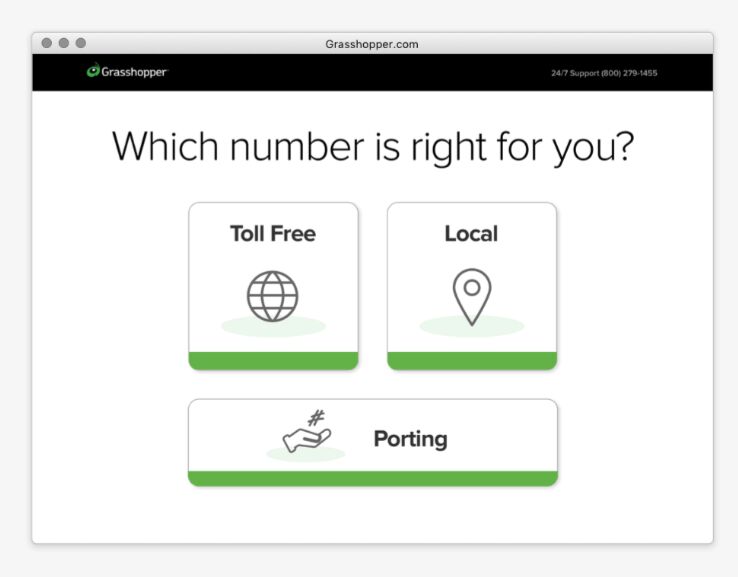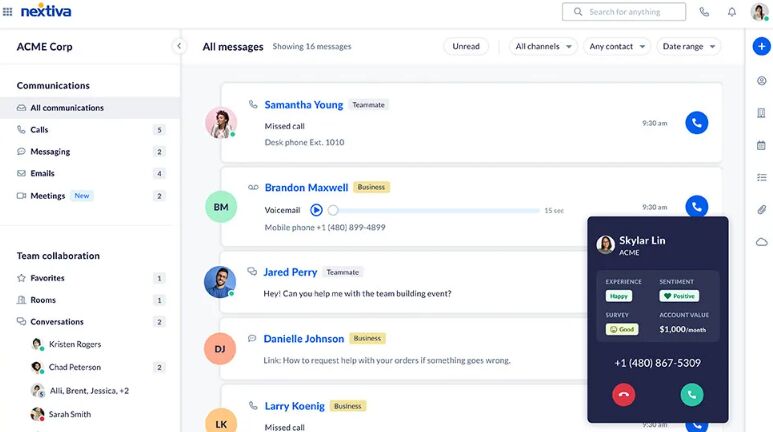If you want to enhance your credibility and connect with customers, it’s vital to get a business phone number that gives you a professional means of communication. To acquire one, determine whether you need a local, toll-free, vanity, or international number. Then, choose your desired service provider and sign up for an account. Below, we’ll explain how to get a business phone number, different number types, top providers, and why you need it for your business.
Grasshopper offers a seamless platform designed to empower entrepreneurs and small business owners alike. Take your business to the next level with streamlined communications. |

|
Step 1: Decide on the Type of Business Phone Number
There are four types of business phone numbers—local, toll-free, vanity, and international—each serving a different purpose. For example, a local number enhances call pick-up rates when targeting customers within a specific area. At the same time, a toll-free number encourages customers to contact your business because there are no call charges.
To help you decide, here’s an overview of the types of business phone numbers, including the key features and their pros and cons.
| PROS | CONS |
|---|---|
| It associates your business with a specific locality. | Customers outside your area code will pay additional fees when calling your local number. |
| It is the cheapest phone number type. | Since it’s tied to a specific area, local numbers can be restrictive if you move locations or travel regularly. |
| It often includes unlimited call minutes. | |
Local phone numbers include an area code tied to a specific location. While voice-over-internet-protocol (VoIP) services offer many local phone numbers based on your business address, you can also request a different area code. These phone numbers typically include unlimited local calls and various calling features.
Therefore, local phone numbers are best for small businesses that want to establish a trusted local presence without setting up a physical branch in a specific locality. Additionally, customers are more likely to answer a call from a number with a familiar area code because it suggests it’s coming from a nearby business.
| PROS | CONS |
|---|---|
| It is free for customers to dial. | It can be pricey for smaller businesses. |
| It projects a national presence and an image of a larger company. | Calls may be perceived as spam or telemarketing. |
Toll-free numbers, also called 800 numbers, start with three-digit prefixes like 800, 888, 877, 866, 855, 844, and 833. These numbers are ideal for businesses wanting to create an image of a larger company with an established national presence.
They are often used for service hotlines, which allow customers to contact a business for free. However, this means that the business owner pays for the call. Therefore, you should expect to shoulder the per-minute fees for every incoming call to a toll-free number.
For a more cost-effective option, VoIP services like RingCentral and Nextiva offer generous toll-free minute allotments (up to 10,000 to 12,500 minutes) on their subscription plans. However, calls exceeding the allotted minutes will incur additional charges.
| PROS | CONS |
|---|---|
| It is easy to remember. | It often requires a setup fee. |
| It boosts brand credibility. | Most vanity numbers are taken. |
| It is an effective marketing tool. | |
The best vanity number providers offer customizable numbers that let you spell words or phrases. These numbers boost your brand recognition by creating catchy and memorable business phone numbers. For example, you can combine vanity numbers with 800 numbers, like 1-800-FLOWERS and 1-888-BEST-BUY, for easy dialing.
At the same time, getting a vanity number for your business can be tricky because many of these numbers are already claimed. They can also be more expensive because VoIP providers charge a setup fee in addition to the monthly charge of up to $200. However, vanity numbers are a great investment because they make it easier for customers to find and remember your business when looking for a specific product or service.
| PROS | CONS |
|---|---|
| It creates an impression that you have a local office in that country. | Not all VoIP providers have this option. |
| It provides international customers with a cheaper way to call your company. | It charges calls per minute. |
International numbers enable businesses to expand worldwide by having a local number in another country. These numbers save customers from the inconvenience of dialing international codes and the cost of long-distance calls.
Many of the best VoIP providers offer international numbers for select countries, so getting an international phone number doesn’t require a physical office or employee in a specific region. Instead, your provider uses the international number to route customer calls to your domestic phone number, which you can pick up on your business phone.
Step 2: Select a Phone Number Provider
Once you know the phone number you need, it’s time to decide which provider to get it from. The most accessible and affordable way to get a business phone number is through cloud-based services, such as a VoIP service provider, a virtual phone solution, or a standalone phone number provider.
The phone number types, functionalities, and costs vary across providers, so it’s essential to consider your budget and feature requirements. To help you start, here are the options to consider:
Industry-leading VoIP Providers
This option works best for businesses seeking a full-fledged cloud phone solution with a phone number. These VoIP phone systems completely replace your existing landline system by offering flexibility and cost-saving benefits. They also deliver many call management features and collaboration tools like team chat and video conferencing.
VoIP Providers | Monthly Starting Price (per User) | Phone Number Types | Key Features |
|---|---|---|---|
 | $25 |
|
|
$30 |
|
| |
 | $19.95 |
|
|
Virtual Number Provider
A virtual phone system is similar to VoIP, as it relies on the internet to transmit calls and comes with a phone number. However, it often has fewer phone features than VoIP, making it ideal for small teams and businesses with low call volumes.
VoIP Providers | Monthly Starting Price (per User) | Phone Number Types | Key Features |
|---|---|---|---|
 | $18 |
|
|
 | $23 |
|
|
 | $19 |
|
|
Standalone Phone Number Provider
Many providers offer standalone phone numbers for a one-time fee. You can forward the number to your phone or port it into your phone system, but it’s better to check with the carrier first to ensure the number is portable. These providers might lack basic calling capabilities, but they’re an excellent alternative for solopreneurs needing a second phone number to separate their work and personal calls.
VoIP Providers | Monthly Starting Price (per User) | Phone Number Types | Key Features |
|---|---|---|---|
 |
|
| |
Step 3: Sign Up for an Account
The next step is to visit the website of your chosen service provider and create an account. Claiming your number varies depending on the provider and usually starts with selecting a subscription plan and then choosing a phone number from the number picker tool filtered by number type and area code.

Pick your number after choosing a plan with Grasshopper. (Source: Grasshopper)
VoIP providers use a self-service approach so that you can claim your number within minutes. After selecting a number, you will be directed to the account information form to enter your name and email. Next, choose your billing cycle (monthly or annually) and add your payment details. After confirming your payment, the phone number is now yours.
Step 4: Set Up Your Phone System
After claiming your phone number, the final step is configuring your phone system. Generally, it involves assigning users and setting up phone features like extensions, call flow, call forwarding rules, and company greetings. However, set-up instructions may vary depending on your provider.

Set up your small business phone system with Nextiva. (Source: Nextiva)
Contact your provider’s support team for a walkthrough, or visit its help center to learn how to set up a business phone number. If you need multiple phone lines, proceed to the admin portal to order additional phone numbers or extensions.
Setting up your phone system can improve agent efficiency and customer satisfaction. It also ensures incoming calls to your main company number are routed to the correct department, reducing callers’ wait times.
Why You Need a Business Phone Number
Whether you’re starting a new business or expanding your current one, you’ll likely need a phone number to help customers reach you via phone call. Here are more reasons why you need to get a business number:
- Separate work and personal calls: A company phone number is a dedicated point of contact for your customers, preventing work calls from being mixed in with personal ones. It also has more call-handling features, allowing you to control how an incoming call can reach you, whether out of the office or at home.
- Enhance business credibility: Credibility drives business. Customers are more likely to answer calls from numbers associated with business lines, especially if you’re using a toll-free or vanity number. These lend an image of professionalism to your company.
- Advanced calling features: When you get a phone number for business from VoIP providers, you can access phone features like auto-attendants and call screening. Additional capabilities like call analytics, call queues, and integrations streamline voice interactions and empower your employees to work from anywhere.
- Access from multiple devices: VoIP and virtual phone number providers deliver capabilities to manage your business communications almost entirely from the cloud. This means your number is usable on any device, including desk phones, tablets, smartphones, and your desktop.
Frequently Asked Questions (FAQs)
To create a business phone number, you first need to select a provider. For example, use a VoIP service provider like Nextiva or RingCentral. Then, choose a plan that fits with your business size and needs. After selecting your plan, choose a local, toll-free, vanity, or international business phone number. Finally, you can set up your phone system with additional features and devices, such as forwarding calls to specific numbers or setting up custom greetings.
Yes, you can use your cell phone number as a business line. Many service providers, like Grasshopper and RingCentral, allow you to access a business phone number from several devices. Simply select a plan and business phone number from a VoIP provider and have your calls forwarded to the cell phone, or use one of the best business phone number apps to take calls from your phone using a business number.
Several providers offer free business phone numbers. For example, Google Voice and TextFree provide a free phone number that allows you to send calls and texts as an individual user. Simply select a provider, decide which type of number you need, sign up for an account, and configure account settings.
Bottom Line
Learning how to get a business number can be a quick and straightforward process as long as you know the type of number you’re looking for and the features you need from a service provider. Launching a business gives you a fair advantage by building trust and credibility with your potential customers early on.
Consider Nextiva if you’re looking for a reliable VoIP solution with automated features. This provider offers several plans for small businesses with all the phone features you need to boost your brand credibility. Sign up for a seven-day trial and get support for startups and growing teams.